Digital customer service tools are the backbone of omnichannel support. Software platforms help businesses manage support from anywhere. The best tools offer AI-powered automation, help desk ticketing, live chat, knowledge bases, and CRM integration. HubSpot Service Hub offers one complete option.
This post explores what teams look for in digital customer service tools and the best solutions available today.
Table of Contents
- What is digital customer service?
- Benefits of Digital Customer Service
- Digital Customer Service Examples
- Digital Customer Service Tools
- At a Glance: Best Digital Customer Service Tools
- Frequently Asked Questions About Digital Customer Service Tools
What is digital customer service?
Digital customer service encompasses all online methods businesses use to support customers — from AI chatbots and email to social media and self-service portals. Unlike traditional phone-based support, digital channels let customers get help on their schedule through their preferred platform.
HubSpot Service Hub provides a complete digital customer service solution that unifies support channels into one platform. Teams can manage live chat, email, chatbots, and social media conversations from a single inbox while leveraging AI to accelerate response times.
Types of Digital Customer Service Tools
Digital service tools allow customers to connect no matter where they are. Popular digital solutions include:
- Help desk software, which centralizes all customer inquiries into a unified ticketing system. Agents can track, prioritize, and resolve issues efficiently while maintaining conversation history across channels.
- Live chat and messaging, which enables real-time conversations on websites or through messaging apps like WhatsApp and Facebook Messenger.
- CRM integration. Customer relationship management tools give agents complete customer context to enable personalized support at scale.
- Knowledge base and self-service, which empower customers to find answers independently through searchable help centers, FAQs, and community forums.
- Social media management, which responds to customer queries across social platforms from one dashboard, ensuring no tweet or comment goes unanswered.
- Analytics and reporting, which track key metrics like response time, resolution rate, and customer satisfaction.
Service Hub includes essential digital service tools in one platform. With a unified system, there’s no need to juggle disconnected tools.
Benefits of Digital Customer Service
1. Boosting Service Quality by Analyzing Feedback
Interacting with clients through a digital channel has one major advantage over face-to-face contact: Teams automatically retain a record of user communication. That includes the emails exchanged, satisfaction surveys sent, and help tickets filed. This data is a goldmine, which can help paint an accurate picture of clients.
AI can help analyze that customer data. With these new insights, teams can better understand common customer concerns. Better yet, service leaders can also set up automatic surveys to continue gathering information. Of respondents, 42% said that they already do this to learn how they can improve their customers’ experiences, according to HubSpot’s State of Service report.
2. Improving Response Time
In the past, getting help meant hours waiting on the phone. That’s all changing thanks to AI. Teams can set up chatbots trained on knowledge base articles to tackle routine questions. This lets service professionals automate answers to the most common questions.
The investment in AI tools pays off for service teams. HubSpot found that 92 percent of specialists say introducing AI and automation speeds up response times. And half of those respondents described the acceleration as “significant.”
3. Meeting Customer Expectations and Improving Satisfaction
Back in the day, calling customer service was the only option. Today, customers can get help via email, live chat, or messaging apps like Facebook. With customers expecting frictionless experiences, digital customer service tools build omnichannel experiences that prioritize convenience.
Beyond that, digital customer service tools bulk up self-service offerings. Teams set up chatbots and service portals that empower customers to solve simple issues. Businesses today are already making the shift. In fact, 64% of companies surveyed by HubSpot say they will increase their investment in self-service options.
4. Establishing Global Reach
Digitizing customer service has another major benefit, and that is offering global reach. Companies can now provide customer support without having a physical office or employing hundreds of people in every market they serve.
Thanks to the use of technology, they can effectively answer queries irrespective of where their customers are. What’s more, they can retain the same standard of customer service, which positively reflects on their brand image.
According to HubSpot's State of Service report, 88% of businesses were able to scale their customer service operations thanks to the use of AI.
5. Cost Savings Through Automation
Digital customer service tools deliver measurable ROI by reducing operational costs while improving service quality. That’s especially true for AI-enabled systems. In fact, 61% of customer service teams that use AI cite cost savings as a benefit.
Automation handles routine queries that would otherwise consume agent time. When chatbots resolve easy incoming requests, the team can focus on complex issues that truly need human expertise. This shift saves money and improves job satisfaction as agents tackle more meaningful work.
Digital Customer Service Examples
Live Chat
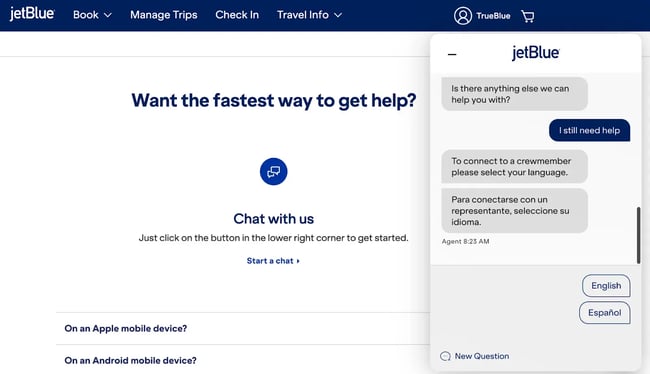
HubSpot found that 42% of respondents currently use live chat, i.e., an online chat with a human representative on the other side. And out of them, 90% agree that they’re effective in serving customers at the right standard.
Pro tip: HubSpot Service Hub offers live chat capabilities that integrate directly with the CRM, giving reps complete customer context during every conversation.
What I like: Personally, I don’t like speaking on the phone, so my favorite thing about live chat is that I can get an answer to my query fast, without calling customer service. And my conversation isn’t available to a third party, unlike when I use social media. It’s the perfect option for those who don’t fancy phone interactions but also don’t want to wait long for an email reply.
Chatbot

In terms of popularity among customer-facing teams, AI chatbots are right up there next to live chat. HubSpot’s study found that they’re currently used by 37% of global service specialists. And this number is set to grow. 71% of respondents told us that they plan to grow their investment in this communication channel.
Pro tip: Service Hub's AI-powered chatbot can be trained on your knowledge base articles to handle common questions. The chatbot seamlessly escalates complex issues to human agents when needed, ensuring customers always get the right level of support.
What I like: They’re available round the clock, so customers can try to find answers to their questions without waiting for your support team to come to work the following day. Chatbots have saved me several times. Not that long ago, I had an issue with my website and it turned out I could fix it myself quickly with the help of a helpful AI assistant. Genius!
Knowledge Base
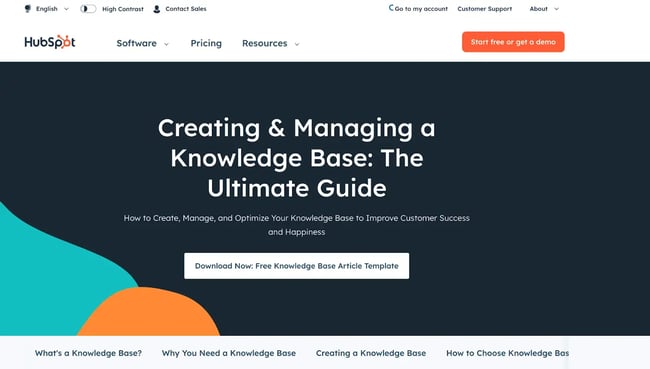
Having a knowledge base is another important self-service feature, right next to chatbots. It’s a collection of the most important information, such as FAQs, an introduction to specific services or features, and quick step-by-step instructions. Customers can easily navigate the categories — or chapters — to find the topic they’re interested in.
What if customers really want to fix issues themselves? According to the companies surveyed by HubSpot, 55% of customers say that they actually prefer to self-serve, rather than wait for a real-life agent.
Pro tip: With Service Hub, teams can build searchable knowledge bases that empower customers to find answers. The platform tracks which articles are most helpful and surfaces content recommendations based on customer behavior.
What I like: Investing time in setting up a knowledge base pays off for both sides. Clients can find answers to their questions, while the brand minimizes the number of incoming communications.
Social Media Management

Currently, over 5 billion people use social media — half of the world’s population. So, it’s hardly surprising that many customers prefer to communicate with brands via Facebook or X, and expect to get their answers quickly. According to HubSpot’s report, 34% of customer service pros use AI to monitor social media for customer service-related issues.
What I like: Social media allows for more personalized communication. Brands can even use a bit of humor at times, which reduces distance and helps to build better relationships with customers. Also, companies can use insights shared by customers to improve the brand experience.
Email Support Systems
Email remains a cornerstone of digital customer service, with modern platforms transforming basic inboxes into powerful support tools. Features like automated routing, canned responses, and collision detection ensure every message gets handled efficiently.
The best email support systems integrate with CRMs to provide full customer context. When an agent opens a ticket, they see purchase history, previous interactions, and relevant account details. There’s no need to have customers repeat themselves.
Pro tip: Service Hub transforms email support with features like automated ticket routing, collision detection, and a unified inbox that consolidates messages from multiple addresses.
What I like: Email gives customers time to fully explain complex issues while providing a written record for future reference. It's particularly effective for detailed technical support or situations requiring documentation.
Self-Service Portals
Self-service has evolved from simple FAQ pages to sophisticated portals where customers can track orders, manage subscriptions, and troubleshoot issues independently. In fact, 88% of customers expect brands to offer an online service portal.
Self-service portals can also be AI-enabled. Artificial intelligence can surface relevant articles based on customer behavior and search patterns. They can even proactively suggest solutions before customers submit tickets, reducing support volume while improving satisfaction.
Pro tip: Service Hub enables businesses to create branded self-service portals where customers can track support tickets, access knowledge base articles, and resolve issues independently.
What I like: Self-service respects customers‘ time and autonomy. When implemented well, it’s faster than waiting for an agent. Customers can also resolve routine issues themselves.
Omnichannel Platforms
Digital customer service tools enable businesses to manage customer support across multiple channels. Omnichannel support unifies communication across email, chat, phone, and social media into one seamless experience. Customers can start a conversation on Twitter, continue via email, and finish through live chat without repeating information.
Omnichannel support requires sophisticated backend integration but delivers exceptional experiences. Agents see the complete interaction history regardless of channel, while customers enjoy consistent service everywhere.
What I like: Omnichannel platforms eliminate the frustration of channel-hopping. They recognize that customers don't think in terms of “channels.” They just want their problem solved efficiently.
Digital Customer Service Tools
The best digital customer service tools offer AI automation, help desk ticketing, live chat, knowledge bases, and CRM integration. To choose the right tool, compare features and pricing to the team's needs. Looking to get started? HubSpot Service Hub provides a unified platform with AI-powered customer service features.
1. HubSpot Service Hub
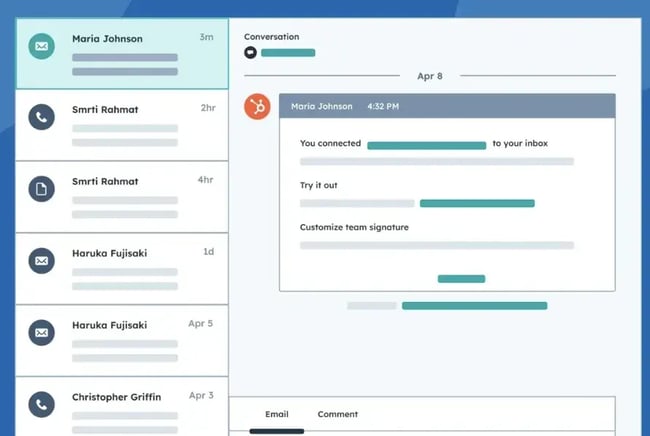
Service Hub brings together customer service data and channels into one CRM platform, making it easy to support and grow any client base.
Service teams can connect live chat, emails, chatbot, and customer feedback tools, among others, and bring all customer messages and tickets into a single place. This is also where teams manage all ongoing communication. That’s right — no more back-and-forth between channels.
By clicking on a customer’s ticket, users can assign a specific customer service representative to the query. Teams can also access all the messages, phone calls, and other interactions that have taken place between the customer and reps so far.
Unsurprisingly, Service Hub also hits the top marks when it comes to AI and automation features. Service teams can create automation rules, such as which types of topics should be assigned to a specific agent or scaled to the customer service team lead.
HubSpot AI is another intelligent feature that acts as an assistant for customer service teams. The agent can help reps rephrase replies so they’re more conversational, heartfelt, or professional. This can be a blessing, particularly when handling a difficult issue.
What I like: Service Hub covers all the use cases I could possibly think of, drawing on my experience as a customer service team member. I particularly love all the handy sidebars and options, like inserting knowledge base articles, answers to FAQs, or rewriting messages with AI for better impact.
All this happens within the chat text field. Bonus points for allowing customer service to enhance knowledge base articles live, based on their interactions with clients.
2. Ada
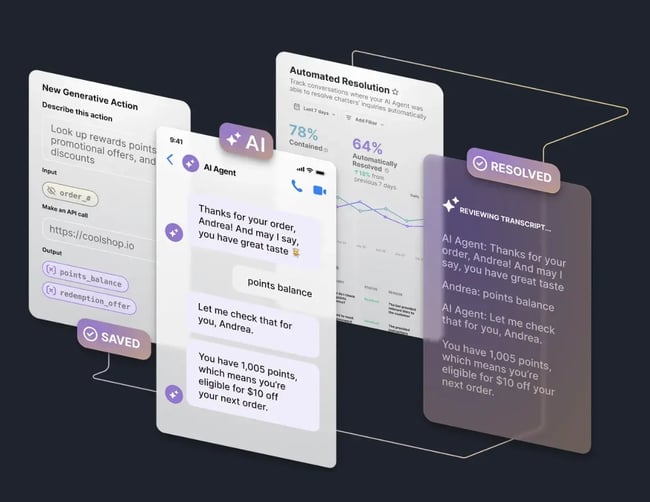
Ada is an AI-powered customer service automation platform, which features a generative AI agent that is able to answer client queries accurately and in real-time.
It’s fast and can come up with relevant responses every single time, thanks to the use of Ada’s Reasoning Engine. It offers personalized responses, learns from previous customer interactions, and can be deployed across multiple digital channels without worrying about losing communication consistency.
What I like: Ada’s ability to understand specific needs and provide answers, which aren’t generic but personalized, is impressive. It makes customers feel valued. It’s always available and ready to assist, so you don’t have to wait in a queue, listening to one tune for 10 minutes (or longer). And the fact that you can deploy it across various channels without compromising response consistency or accuracy is just great.
3. Intercom
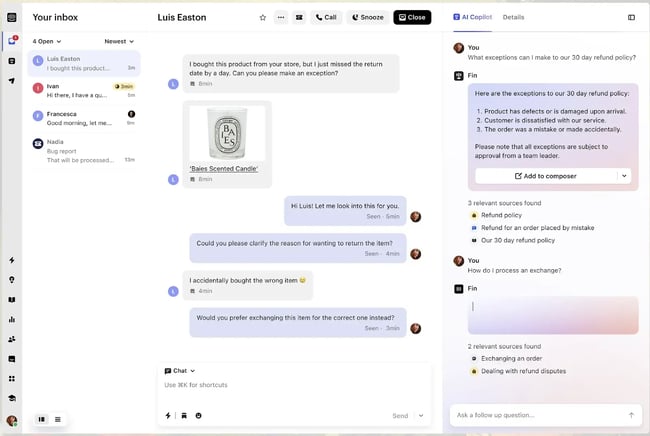
It’s hard to find a customer service pro who hasn’t heard of Intercom. It’s an AI-first customer service solution, which among others features a live chat, chatbots, and targeted messaging capabilities. Their Fin AI Agent provides 24/7 support and is able to resolve 50% of support volume instantly.
What I like: What’s truly amazing about Intercom is that it’s a complete service platform that caters to clients, agents, and leaders alike. Their AI agents answer queries quickly and only pull answers from your support content — so you don’t have to worry about accuracy.
The AI Copilot makes pulling answers really easy, and users can even change the tone of voice to make it sound more human. And it’s got access to all the questions and answers that have been generated in the past, so teams can get a more accurate response. When reps want to raise a ticket, their AI automatically describes the issue, which is a real time saver.
4. Help Scout
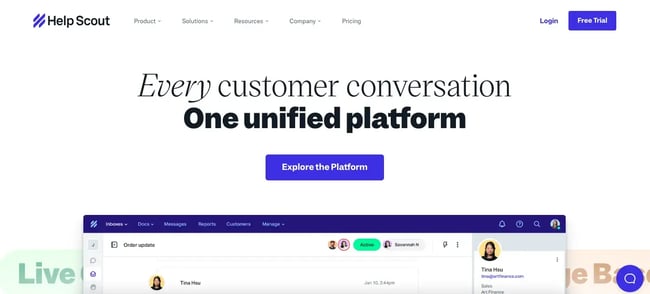
Help Scout lets teams bring all client communication into one platform and keep a handy record of previous conversations. Among others, reps can add tags and internal notes to client messages to make it easier to handle communication now and in the future.
Help Scout’s communication platform also lets users set automation rules that will accelerate the time to resolution. For example, if a customer asks a question about international shipping, teams can automatically draw relevant information from FAQs.
I also appreciate the fact that the platform is keeping up with the times and uses AI to help the support team. Among others, you can ask AI to read a long email, or even an entire thread, and condense it into a high-level summary.
It can also adjust the tone of voice or message length.
What I like: One feature that caught my eye is ‘real-time collision detection.’ It shows you if someone else is also replying to a request or viewing it, preventing you from sending two responses. This could happen if you handle tens or hundreds of messages every day.
5. Zendesk

Zendesk is a digital customer service tool that provides omnichannel support. The platform centralizes customer interactions into a unified workspace, allowing reps to manage requests efficiently without switching between systems. Beyond that, Zendesk offers automation, including intelligent routing and chatbots, which help teams resolve issues faster.
Zendesk includes robust self-service capabilities through customizable knowledge bases and community forums. The platform also supports extensive customization through apps and integrations with hundreds of business tools, allowing organizations to tailor their workflows.
What I like: I find Zendesk‘s interface intuitive and rep-friendly, which reduces training time and helps teams get productive quickly. Comprehensive reporting also gives me clear visibility into what’s working and where improvements are needed.
6. Hiver
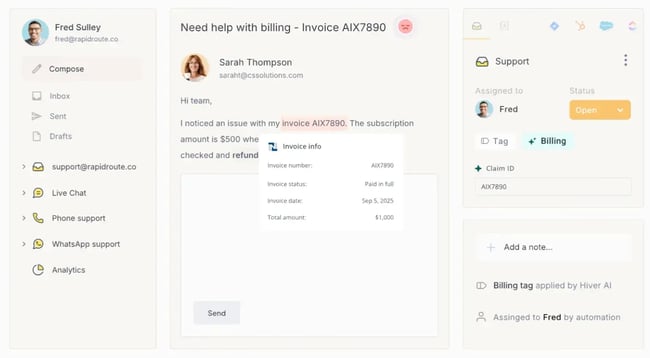
Hiver is a customer service platform built directly into Gmail. With Hiver, ordinary inboxes become a collaborative helpdesk. The platform provides features:
- Email assignment.
- Collision detection to prevent duplicate responses.
- Internal notes for team collaboration.
- And SLA tracking.
Hiver includes automation rules for routing emails based on keywords or sender information. It also offers email templates for consistent responses and analytics dashboards that track team performance.
What I like: I love that Hiver eliminates the learning curve associated with traditional helpdesk software by working right inside Gmail. I also appreciate the transparency Hiver brings to shared inbox management. Teams can see exactly what my teammates are working on and where help might be needed without constant check-ins.
7. Zoho Desk
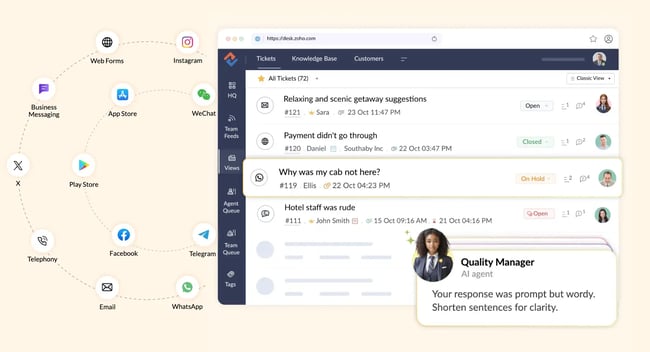
Zoho Desk organizes customer interactions into a unified ticket management system with customizable views, automated workflows, and multi-department routing capabilities. The platform offers extensive self-service options through branded help centers, community forums, and AI-powered chatbots that can resolve common queries without agent intervention.
As part of the broader Zoho ecosystem, the platform integrates seamlessly with Zoho CRM and other Zoho applications, while also supporting integrations with third-party tools.
What I like: With Zoho, teams can configure workflows and automations to match exactly how teams already work, rather than forcing users to adapt to rigid software limitations.
8. Freshdesk
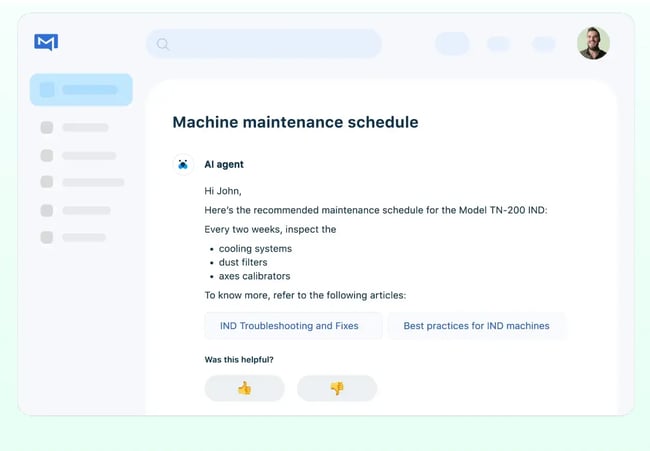
Freshdesk is a cloud-based customer support platform that enables businesses to manage customer conversations across channels from a single interface. The platform features intelligent ticket management with automatic routing and prioritization powered by AI. Freshdesk's Freddy AI assists agents with suggested responses, identifies intent, and can handle routine inquiries, allowing human agents to focus on bigger challenges.
Freshdesk’s reporting suite offers pre-built and custom reports. Teams can get insight into how agents perform and customer satisfaction after support interactions.
What I like: I appreciate Freshdesk‘s clean, modern interface that doesn’t feel overwhelming even with all its features. The mobile app is genuinely useful too, allowing teams to stay responsive to urgent issues even when they’re away from their desks.
9. LiveAgent
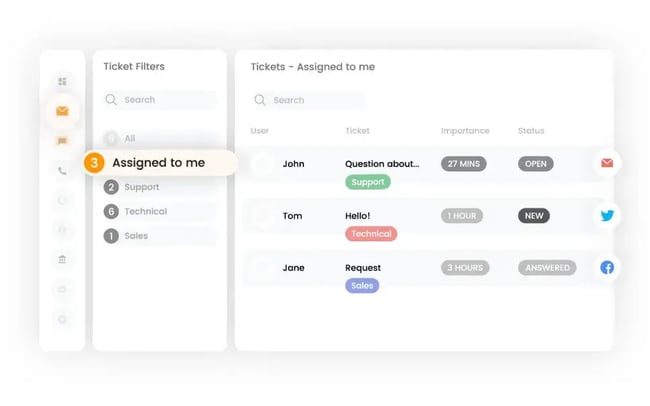
LiveAgent is an all-in-one customer service software that combines live chat, ticketing, call center, and social media management into one platform. The platform offers comprehensive call center functionality, including unlimited call recording, making it suitable for businesses that handle a significant phone support volume.
LiveAgent features a universal inbox that aggregates customer communication, ensuring no inquiries are missed. Additionally, LiveAgent's real-time live chat has distribution rules that connect customers with the most appropriate agent based on skills, availability, and department.
What I like: The call center features are robust for the price point, offering professional phone support capabilities without requiring separate software.
10. Salesforce Service Cloud

Salesforce Service Cloud is an enterprise-grade customer service platform that provides comprehensive case management and support capabilities. Service Cloud features Einstein AI that offers predictive routing to match customers with the best-qualified agents and automated responses for common inquiries.
As part of the broader Salesforce ecosystem, Service Cloud integrates seamlessly with Sales Cloud, Marketing Cloud, and thousands of third-party applications through the AppExchange marketplace.
What I like: I appreciate how Service Cloud gives users complete customer context in one place. Reps can see a customer's entire relationship with the company, from their first purchase to every support interaction.
At a Glance: Best Digital Customer Service Tools
|
Software |
Best For |
Starting Price |
Free Plan |
Key Features |
|
HubSpot Service Hub |
All-in-one CRM integration |
$15/user/month |
Yes |
AI assistance, unified inbox, knowledge base |
|
Ada |
AI automation |
Custom pricing |
No |
Conversational AI, reasoning engine |
|
Intercom |
AI-powered support |
$29/user/month |
Free trial |
AI chatbots, proactive messaging |
|
Help Scout |
Email-focused teams |
$50/user/month |
Yes |
Shared inbox, collision detection |
|
Zendesk |
Enterprise customization |
$19/user/month |
No |
1000+ integrations, advanced analytics |
|
Hiver |
Gmail integration |
$25/user/month |
Yes |
Email collaboration, automation |
|
Zoho Desk |
Budget-conscious teams |
$7/user/month |
No |
AI assistant, workflow automation |
|
Freshdesk |
Small to medium businesses |
$15/user/month |
No |
Multichannel support, automation |
|
LiveAgent |
Live chat focus |
$15/user/month |
No |
Real-time dashboards, gamification |
|
Salesforce Service Cloud |
Large enterprises |
$25/user/month |
No |
Einstein AI, full CRM ecosystem |
How to Choose the Right Platform
Consider these factors when evaluating options:
- Team size and growth plans to ensure the platform scales with the team.
- Primary support channels that match how customers contact the business.
- Integrations that are compatible with existing tools.
- The team’s total budget, including add-ons.
- Technical requirements that balance features with ease of use.
The best choice depends on a team’s specific needs, but starting with a free trial helps validate fit before committing.
Frequently Asked Questions About Digital Customer Service Tools
What are CRM tools for customer service?
CRM software can centralize customer information, track support tickets, and enable teams to respond to inquiries across multiple channels. By keeping all customer history in one place, CRMs help support teams provide faster, personalized service while maintaining consistency.
HubSpot Service Hub is a comprehensive CRM tool for customer service that unifies ticketing, live chat, email, and knowledge base management in one platform. Built on HubSpot's CRM, Service Hub gives agents complete customer context for efficient support.
How much does customer service software cost?
Pricing for customer service software ranges from free plans to enterprise subscriptions. Basic help desk solutions start around $7-25 per user per month, while mid-tier platforms with advanced features typically range from $50-100 per user monthly. Many providers offer tiered pricing plans. Service Hub offers a free plan with paid plans starting at $15 per user monthly.
What's the difference between help desk and customer service software?
Help desk software focuses on ticket management and issue resolution. Customer service software is broader in scope, encompassing help desk functionality plus additional capabilities. Broader customer service software may also offer multi-channel support, customer relationship management, self-service portals, and advanced analytics.
How long does implementation typically take for digital customer service tools?
Implementing digital customer service tools can reduce response times and improve customer satisfaction. Timelines typically range from a few days to several months, depending on system complexity. Basic cloud-based solutions with standard configurations can be set up in one to two weeks. More complex deployments may take two to six months.
Can digital customer service tools integrate with my existing systems?
Digital customer service tools integrate with existing CRM and business systems. Many solutions provide pre-built integrations with popular software, while others offer APIs and webhooks for custom connections. Common integrations include:
- CRM platforms.
- Ecommerce systems.
- Marketing automation tools.
- Communication channels.
- Payment processors.
HubSpot Service Hub integrates with hundreds of popular business tools through native integrations and the HubSpot App Marketplace.
Digital Customer Service Tools — Multichannel is The Way to Go
Each customer has their own preference — I, personally, really dislike calling brands. Whenever possible, I go for email or chat, but I can’t say the same of my parents. They’ll always choose to speak to a brand over the phone. It’s how they’ve been getting answers to questions for decades.
Less-tech-savvy clients will tend to choose face-to-face and calls, but Millennials and Gen-Z will prefer getting things done on screen.
What I recommend is choosing an omnichannel communication approach, so that you can resolve issues for everyone, faster and more efficiently.
.png?width=112&height=112&name=Image%20Hackathon%20%E2%80%93%20Vertical%20(67).png)
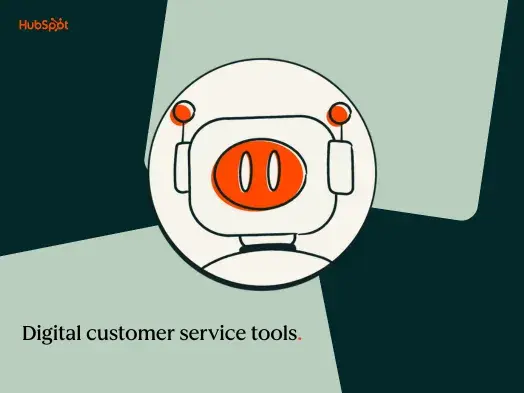
.png)

![How to Implement a Hybrid Customer Service Strategy That Works [Expert Tips]](https://53.fs1.hubspotusercontent-na1.net/hubfs/53/hybrid%20customer%20service_featured.png)
![After Sales Service Strategy: What It Is & Why It's Important [+Examples]](https://53.fs1.hubspotusercontent-na1.net/hubfs/53/after-sales-service.jpg)

![6 Customer Service Recovery Strategies to Add to your Toolbox [+ Examples]](https://53.fs1.hubspotusercontent-na1.net/hubfs/53/service=recovery.jpg)
